You've come to the right place to answer your "how long does it take to
replace motor mounts" question.
Depending on your vehicle's engine, it can take anywhere between half
an hour and four hours to replace motor mounts.
However, certain factors, like how easy it is to access the mounts and
whether you need to replace all of them, can shorten or lengthen the
process.
We'll cover the duration, procedure, ease, cost, and more in the sections
below.
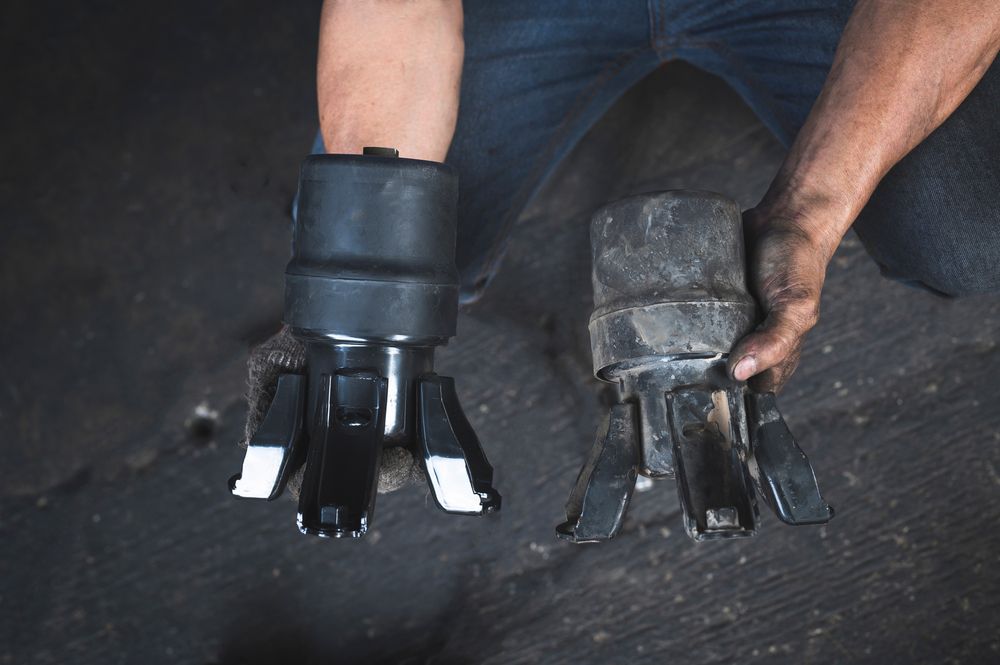 New versus old motor mounts.
New versus old motor mounts.
How Long Should It Take To Replace Engine Mounts?
The engine mount holds your car's engine in place.
Most vehicles also have a transmission mount and two or three motor mounts
that hold the engine in place, reducing noise and movement.
These mounts are attached to the chassis side, while the engine is tied to
other sections of the car's body due to its spinning elements.
Unfortunately, an engine mount isn't built to last forever, so you will
need to go about replacing bad motor mounts at some point.
It can take anywhere between 30 minutes and four hours to conduct a motor
mount replacement for a V12 or V8 engine.
The specific time depends on the engine mount's accessibility and the
number of mounts requiring replacements.
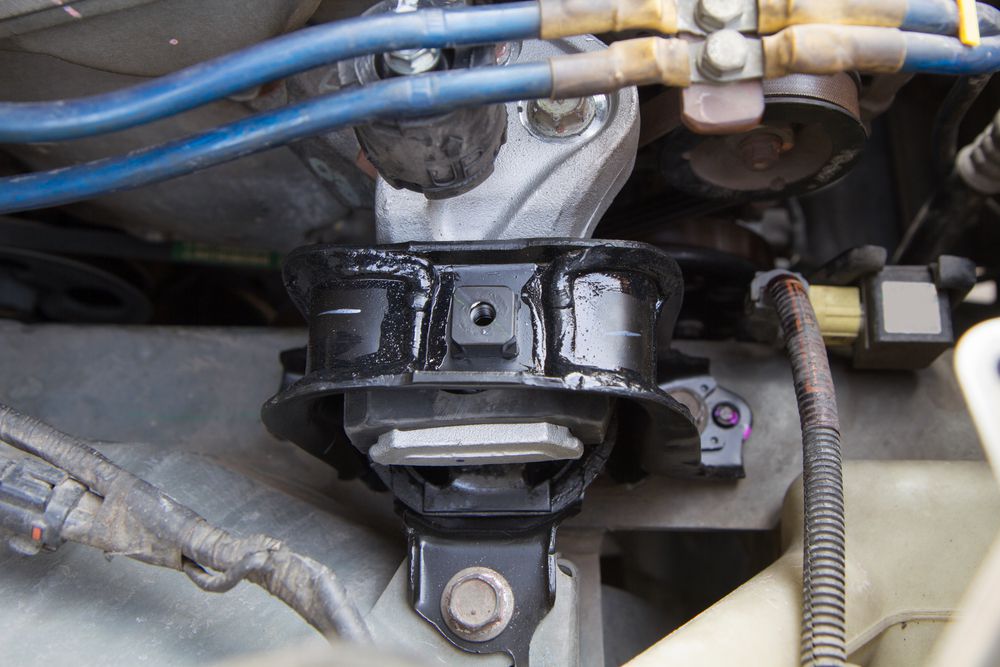 Newly installed motor mount.
Newly installed motor mount.
How Many Hours Does It Take To Replace Motor Mounts?
Depending on the ease of reaching the engine mounts, it can take between
half an hour and four hours to replace them.
Not to mention the service time could increase greatly if the mechanic
finds problems with other mounts or components.
Should I Replace All Engine Mounts At Once?
You don't have to replace every engine mount at the same time.
But keep in mind that they all carry equal lifespans, so you'll need to pay
close attention to the mounts you aren't changing.
The damage's severity will determine whether you need one mount replaced or
all of them.
How Long Does It Take To Replace 1 Motor Mount?
Different cars contain their engine mounts in different places, meaning
others are harder to reach.
So, it can take anywhere from two to four hours to change a motor mount.
Mechanics can generally access the mounts in most older vehicles, those
with larger bodywork, and cars with smaller engines in an hour.
How Many Mounts Does An Engine Have?
Most engines have two mounts.
However, larger vehicles, like minivans, tend to have three.
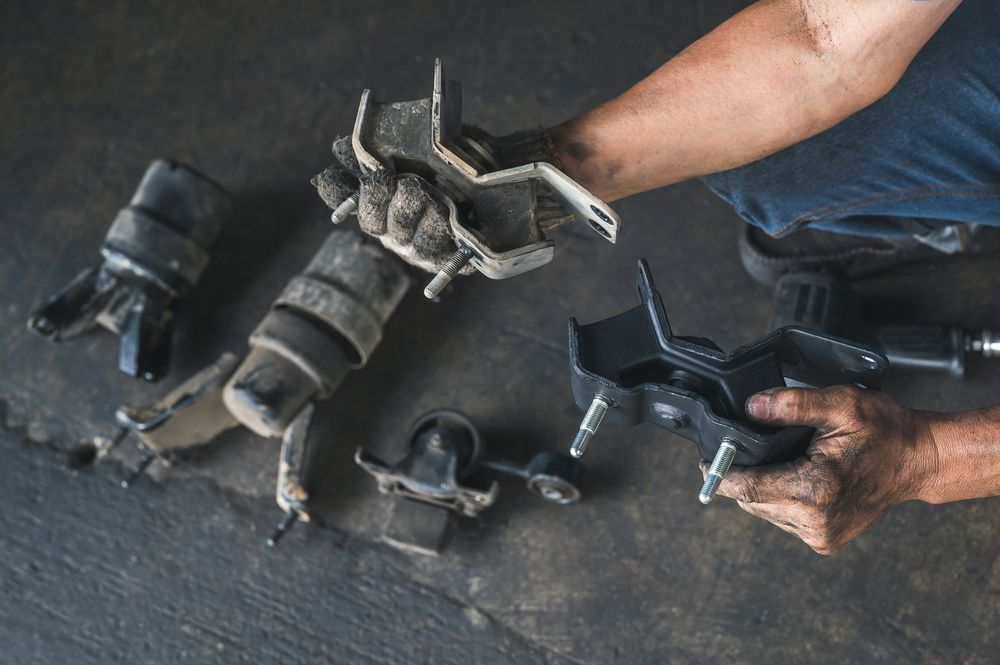 A mechanic comparing a new versus old motor mount.
A mechanic comparing a new versus old motor mount.
Are Motor Mounts Easy To Replace?
If you have some DIY experience, replacing bad motor mounts isn't too
difficult.
Follow these steps:
-
Put a solid wood block against the rear wheels.
-
Locate the motor mounts.
-
Engage the parking brake, jack the vehicle, and use jack stands to
support it.
-
Take off the mount bolts from the engine side, then the chassis.
-
Use the jack to slowly lift the engine.
-
Look at the pumps to ensure you have full clearance.
-
Remove the faulty mount.
-
Transfer the heat shields to the new mount.
-
Put the new mount in place.
-
Bolt the chassis side, tightening by hand.
-
Slowly align the engine with the mount, bolting the engine side and
torquing properly.
How Hard Is It To Replace Motor Mounts?
The replacement process isn't complicated but can be tricky if things like
crimped AC lines or hoses get in the way or you don't have much mechanical
experience.
 A customer paying her mechanic.
A customer paying her mechanic.
How Much Does It Cost To Replace Your Motor Mount?
Since motor mounts are just an engine damper and bolt, they aren't complex,
meaning they're a relatively affordable part.
You can usually buy engine mounts for under $45, typically capping out
around $200.
We suggest investing in decent-quality engine mounts to prevent early
cracks or wear and save money in the long run.
Even though the part is somewhat cheap, the cost of a motor mount
replacement runs between $400 and $1,000.
Unfortunately, motor mounts aren't easy to access, and replacing engine
mounts requires supporting the engine itself while doing so.
Therefore, most of the replacement cost covers the mechanic's labor.
If you have a minivan or similar vehicle with three motor mounts that are
hard to reach, you should expect the labor fees to be even higher.
Plus, you'll often need to replace multiple engine mounts, potentially
increasing the cost.
How Do I Check Motor Mounts
Without properly functioning engine mounts, the torque produced by the
vehicle's engine can cause engine movement, resulting in an excessive
vibration since nothing is absorbing energy.
Therefore, checking your engine mounts is key to ensure they continue
providing the vibration dampening effect.
Luckily, you can check them at home by following the steps below:
-
Pull the lever to pop the hood and find the engine mounts. They're
usually found on the engine side, front, and back. Smaller engines may
have two mounts, whereas vehicles with larger engines may have three.
Normally, you can find the third by the firewall. We recommend
consulting your repair manual to find them easier.
-
Ask somebody to turn the car on and rev the engine. Look at the left
motor mount; it will be pulled when revving. While the engine will
move, but mount should not. So, if you see excessive movement here, you
need to replace motor mount.
-
Next, check the passenger or right engine mount. Typically revving the
engine compresses this one. However, it still shouldn't move.
-
If applicable, check the rear mount as you did in step two.
-
Finally, check all motor mounts while somebody revs the engine. Even if
you don't see any overt movement, check the associated parts like the
fan or shroud.
If your engine block steers clear of any spinning elements and other
components, you likely don't need to worry about fitting a new engine mount
or two.
 An accident can damage a motor mount.
An accident can damage a motor mount.
What Makes Motor Mounts Go Bad?
There could be all sorts of reasons behind your failed motor mount,
however, some of the most common reasons are as follows:
#1 Accidents
Whether you've recently suffered a prang or are looking to buy a used
vehicle, it's worth noting this obvious cause of a failed motor mount.
Even if the car body suffered only minor cosmetic damage, the momentum
transfer could have caused a crack in your motor mount.
Since the vehicle's previous owner may not realize, it's worth getting them
checked by a trusted service center before purchasing to ensure you're not
driving around on a nearly failed engine mount.
#2 Defective or Worn Engine Mounts
While unlikely, the motor mounts you purchase from the store could be worn.
Sometimes, online bulletins or service station announcement boards will
post recall information about worn engine mounts, so be on the lookout for
that.
Be ultra-careful when buying a refurbished engine mount, as it's more
likely to be defective upon purchase.
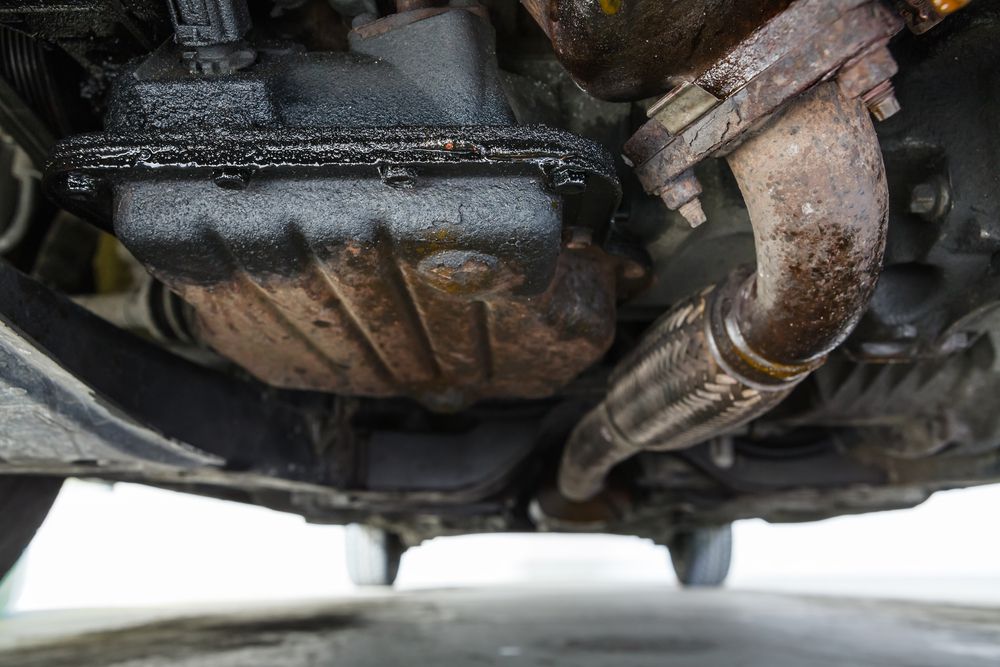 Engine oil leaks can damage motor mounts.
Engine oil leaks can damage motor mounts.
#3 Oil or Fluid Leaks
Oil and other fluids consistently leaking onto your engine mounts can
compromise the rubber.
Ultimately, this could lead to a prematurely broken mount.
If your vehicle is leaking transmission fluid, oil, or other liquids, take
it to a qualified mechanic as soon as possible to prevent bad motor mounts.
#4 Manual Transmission Driving Style
The best part about driving manual vehicles is the control.
You tell your vehicle's engine when, where, and how to change gears.
However, such power shouldn't be abused because it can cause worn engine
mounts relatively quickly.
Normally, this happens when you:
-
over-rev your gears;
-
slam the vehicle; or
-
let out the clutch before takeoff.
Driving like this drastically reduces the lifespan of your engine mounts.
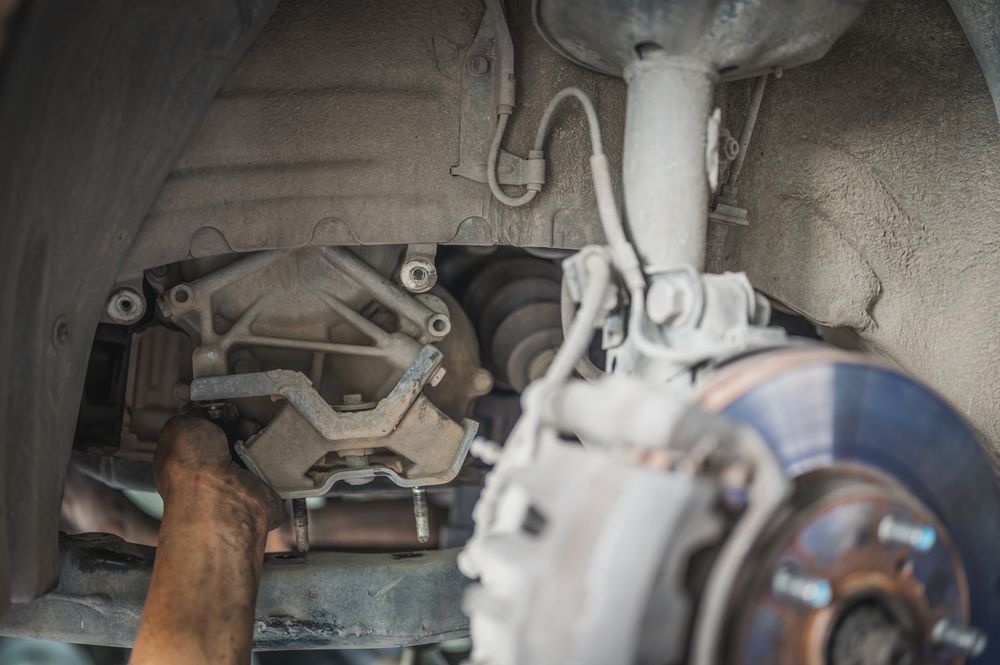 Installing a new motor mount.
Installing a new motor mount.
#5 Improper Engine Mount Installation
Make sure the garage has the right equipment for the engine mount
replacement.
Less reputable shops might be less costly, but it could lead to improper
motor mount installation, inevitably causing excessive wear and increasing
the chances of failure.
#6 Age or Stress
Nothing lasts forever, including motor mounts.
Over time, the rubber casing deteriorates and small cracks begin appearing,
causing fluid leaks.
Once leaking happens from a liquid-filled mount, it's time to replace it.
Failing to do so will cause excessive vibrations and loud cabin noise.
What Does A Worn Engine Mount Sound Like?
One of the most common symptoms of worn mounts is repeated impact noise
inside the engine bay.
From clunking sounds to banging noises to clanking, it's probably caused by
the failure of at least one motor mount.
The sound occurs because the engine isn't sitting snuggly into its slot
anymore, hard shifting from left to right inside the engine bay.
But the extra movement isn't just headache-inducing; it can also damage
delicate components like radiator hoses and fan belts.
What Does A Broken Motor Mount Feel Like?
Alongside the sound, you'll notice an increased vibration that worsens at
high speeds.
When the dampening fluid or rubber casing deteriorates, the engine mount is
no longer secure, causing the vehicle to vibrate noticeably.
You'll feel it most through the steering wheel while your car is idling.
Can Motor Mounts Cause Shaking?
Yes, the added vibrations can cause shaking throughout your car, however,
it's always more prominent nearer the engine.
What Does A Near-Failing Engine Mount Look Like?
Aside from more noise and added vibrations, dying engine mounts often have
cracks, tears, or leaks.
That said, if there is significant damage to the internal structure, you
may see none of the above but notice a decrease in height.
How Long Can I Drive With A Broken Motor Mount?
It's still safe to drive your vehicle with a worn motor mount, provided any
engine movement caused doesn't exceed a few inches — anything over that,
it's to replace motor mounts.
However, if you're noticing vibrations and can confirm it's at least one
engine mount, you shouldn't drive for too long.
We recommend taking your car to your trusted mechanic as soon as possible.
Can Motor Mounts Cause Transmission Problems?
A bad engine mount can cause a myriad of transmission problems, such as:
-
Transmission oil pan leakage —
Thanks to the excessive shaking or vibrating, the transmission's joints
and gaskets loosen, increasing the likelihood of oil leaks.
-
Lack of response —
Poor motor mounts throw the transmission's internal parts out of
alignment. Thus, the gears won't engage properly.
-
Torque converter malfunction —
All the vibrations can cause breakage of the joint between the torque
converter and engine, causing failure or improper function.
Conclusion
In 30 minutes to four hours, you can replace motor mounts, reducing noise
and ensuring the proper functioning of your car.
The process is relatively easy, especially when you have DIY experience,
and it'll take less time if you don't have to replace all engine mounts.